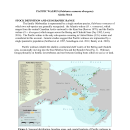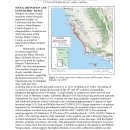States
Alaska, California, Florida, Puerto Rico, WashingtonEcosystem
MarineOne of the objectives of the Marine Mammal Protection Act (MMPA) is to ensure species or stocks of marine mammals occurring in waters under the jurisdiction of the United States are neither permitted to diminish beyond the point at which they cease to be a significant functioning element of their ecosystem nor permitted to diminish below their optimum sustainable population optimum sustainable population
With respect to any marine mammal population stock, the number of animals which will result in the maximum productivity of the population or the species, keeping in mind the carrying capacity of the habitat and the health of the ecosystem of which they form a constituent element. [defined under MMPA Section 3(9)]
Learn more about optimum sustainable population . Section 117 of the MMPA provides for the development of stock assessment reports (SARs). SARs are based on the best scientific information available, prepared in consultation with established regional scientific review groups, and include:
A description of the geographic range of the affected stock, including any seasonal or temporal variation in such range
The minimum population estimate, current and maximum net productivity rates, and current population trend, including a description of the information upon which these are based
An estimate of the annual human-caused mortality and serious injury by source and, for a strategic stock strategic stock
A marine mammal stock (a) for which the level of direct human-caused mortality exceeds the potential biological removal level; (b) which is declining and is likely to be listed under the U.S. Endangered Species Act; or (c) which is listed under the U.S. Endangered Species Act, or is designated as depleted under the MMPA. [defined under MMPA Section 3(19)]
Learn more about strategic stock , other factors that may be causing a decline or impeding recovery of the stock, including effects on marine mammal habitat and preyA description of commercial fisheries that interact with the stock, including:
The approximate number of vessels actively participating in each such fishery
The estimated level of incidental mortality and serious injury of the stock by each such fishery on an annual basis
Seasonal or area differences in such incidental mortality or serious injury
The rate, based on the appropriate standard unit of fishing effort, of such incidental mortality and serious injury, and an analysis stating whether such level is insignificant and is approaching a zero mortality and serious injury rate
The status of the stock as one that either: (1) has a level of human-caused mortality and serious injury that is not likely to cause the stock to be reduced below its optimum sustainable population; or (2) is a strategic stock, with a description of the reasons therefor
An estimate of the potential biological removal level potential biological removal level
The maximum number of animals, not including natural mortalities, that may be removed from a marine mammal stock while allowing that stock to reach or maintain its optimum sustainable population. The potential biological removal level is the product of the following factors: (a) the minimum population estimate of the stock; (b) one-half the maximum theoretical or estimated net productivity rate of the stock at a small population size; and (c) a recovery factor of between 0.1 and 1.0. [defined under MMPA Section 3(20)]
Learn more about potential biological removal level for the stock, describing the information used to calculate it, including the recovery factor.
The Service reviews SARs annually for strategic stocks and triennially for non-strategic stocks. If the Service’s review indicates the status of the stock has changed or can be more accurately determined, the Service revises the SAR, which includes a 90-day public comment period.
For information on dolphins, porpoises, whales, seals, and sea lions, contact the National Marine Fisheries Service's Office of Protected Resources.





















